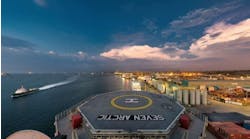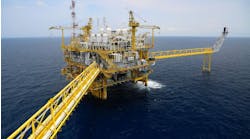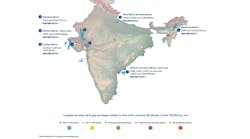As the Gulf of Mexico lures exploration dollars into its deeper waters, Halliburton addressed the deepwater technology focus by mobilizing the Subsea Viking from the North Atlantic.
"We saw this vessel as working solely in the deepwater," Halliburton Subsea General Manager for the Gulf of Mexico Dick Martin said of the 1999-build designed for deepwater intervention.
The deepwater market is rapidly expanding, he said, "and we thought there is a gap there that needs to be filled."
And fill it Halliburton did. For $50 million, the vessel is all Halliburton.
"The (remotely operated vehicles) ROVs are actually built into the ship," Martin said. The integration from the ground up accommodates the ROV handling system into the fabric of the vessel.
For now, the Subsea Viking will work with two ROVs, but it worked with four ROVs during its stint off West of Shetlands for BP. The vessel has two moonpools, with one dedicated to ROV launch and recovery and the other for through-hull underwater work. The work moonpool is 6 m by 6.6 m, and the ROV moonpool is 6 m by 5.4 m. The vessel contains an on-line room, an off-line room, digital video grabbing, report writing, charting, data processing, video review and edit, and an ROV control room to support the ROV focus of the vessel.
The multipurpose support vessel (MSV) was built to dynamically positioned 3 standards for the highest level of redundancy possible for a vessel, Martin said. The triple redundancy of the Kongsberg Simrad system yields more stability, vital for when the Subsea Viking is performing sensitive tasks in deepwater next to platforms, he said.
The 103-m vessel can support operating oil companies for the life of a field, Halliburton said. The Subsea Viking has systems to handle flowline/umbilical tie-ins to depths exceeding 1,500 m, and it holds three passive roll reduction tanks to counter motions during lifting operations. The 19.5-m-diameter helideck can land the Super Puma, and the vessel's 100-ton deck crane is rated to 5,000 ft. The Norwegian-flagged vessel accommodates 70, has eight state cabins, 16 single cabins, and 23 doubles. A crew dedicated to the Subsea Viking operates the vessel.
Using a crew that travels with the vessel "results in a safer and more productive environment, and it results in maintenance of the vessel," Martin said. Indeed, the interior of the three-year-old vessel looks new, featuring leather furniture in the day rooms and crew rooms. The single- and double-occupancy crew rooms also contain televisions and stereo systems. Martin said the initial outlay for quality furniture and furnishings compels the crew to take better care of the vessel.
Short-term assignments
The Subsea Viking, built at the UMOE Sterkoder yard in Kristiansund, Norway, mobilized to the Gulf of Mexico in February in preparation for work on Shell's Manatee Field in Green Canyon Block 155 in 1,940 ft water depth. The vessel also completed contracts with Allseas for work on the Nakika Field in Mississippi Canyon Block 474 and pre-mat installation on Horn Mountain in Mississippi Canyon Block 127.
Before mobilizing to the Gulf, the Subsea Viking worked in the North Sea, providing deepwater support with ROV work and remote tie-ins and connections of flexible lines, and in West of Shetlands, providing deepwater tie-ins. Additionally, the Subsea Viking laid deepsea communication cables in the Mediterranean and along the west coast of the US.
Martin said the company plans to keep the Subsea Viking in the Gulf of Mexico with a continuing program.
"You need to match the support equipment with the technology challenge," he said.




